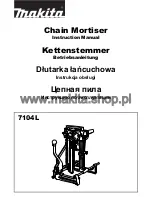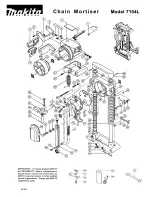
34
4) Power tool use and care
a)
Do not force the power tool. Use the correct power tool for your application.
The correct power
tool will do the job better and safer at the rate for which it was designed.
b)
Do not use the power tool if the switch does not turn it on and off.
Any power tool that cannot be
controlled with the switch is dangerous and must be repaired.
c)
Disconnect the plug from the power source and/or the battery pack from the power tool before
making any adjustments, changing accessories, or storing power tools.
Such preventive safety
measures reduce the risk of starting the power tool accidentally.
d)
Store idle power tools out of the reach of children and do not allow persons unfamiliar with the
power tool or these instructions to operate the power tool.
Power tools are dangerous in the hands
of untrained users.
e)
Maintain power tools. Check for misalignment or binding of moving parts, breakage of parts and
any other condition that may affect the power tool’s operation. If damaged, have the power tool
repaired before use.
Many accidents are caused by poorly maintained power tools.
f)
Keep cutting tools sharp and clean.
Properly maintained cutting tools with sharp cutting edges are
less likely to bind and are easier to control.
g)
Use the power tool, accessories and tool bits etc. in accordance with these instructions, taking into
account the working conditions and the work to be performed.
Use of the power tool for
operations different from those intended could result in a hazardous situation.
h)
Keep handle dry, clean and free from oil and grease.
Slippery handles do not allow for safe handling
and control of the power tool in unexpected situations.
5) Use and handling of the cordless electrical power tool
a)
Charge a rechargeable battery unit using only the charger recommended by the manufacturer.
Chargers are often designed for a particular type of rechargeable battery unit. There is the danger of
fire if other types of rechargeable battery units are used.
b)
Only the rechargeable battery units supplied are to be used with an electrical power tool.
The use
of other rechargeable battery units may lead to the danger of injury or fire.
c)
When they are not being used, store rechargeable battery units away from paperclips, coins, keys,
nails, screws or other small metal objects that could cause the contacts to be bridged.
Short-circuiting the contacts of a rechargeable battery unit may result in heat damage or fire.
d)
Fluids may leak out of rechargeable battery units if they are misused. If this happens, avoid contact
with the fluid. If contact occurs, flush the affected area with water. Seek additional medical help if
any of the fluid gets into your eyes.
Escaping battery fluid may cause skin irritation or burns.
6) Service
a)
Have your power tool serviced by a qualified repair person using only identical replacement parts.
This will ensure that the safety of the power tool is maintained.
ADDITIONAL SAFETY RULES FOR JIG SAW
Hold the electric tool by the insulated handles when you are carrying out work during which the
electric tool may come into contact with concealed power cables or its own power cable.
Contact with
a live cable may also cause metal parts of the appliance to become live and lead to electric shock.
Keep your hands away from the sawing area. Do not reach underneath the workpiece.
Contact with
the saw blade may result in injury.
Keep your hands away from the stroke rod and the quick-release chuck.
Contact with these
components may result in a crushing injury.










































